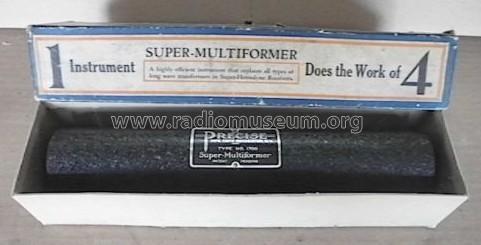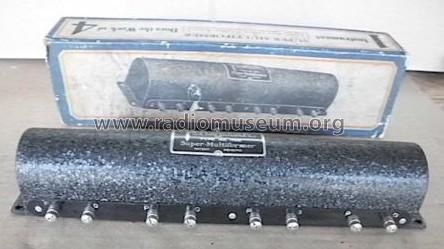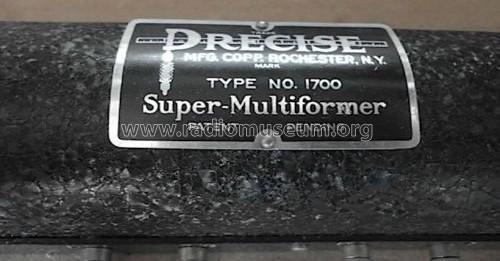Super-Multiformer 1700
Precise Manufacturing Corporation.; Rochester, NY
- Land
- USA
- Hersteller / Marke
- Precise Manufacturing Corporation.; Rochester, NY
- Jahr
- 1925 ?
- Kategorie
- Radio Baugruppe vor 1926 (kein Bauteil, keine Taste)
- Radiomuseum.org ID
- 262573
- Betriebsart / Volt
- Keine Stromversorgung
- Lautsprecher
- - - Kein Ausgang für Schallwiedergabe.
- Material
- Metallausführung
- von Radiomuseum.org
- Modell: Super-Multiformer 1700 - Precise Manufacturing
- Form
- Diverse Formen, unter Bemerkung beschrieben.
- Bemerkung
-
The Precise Super-Multiformer No. 1700 was a groundbreaking radio component introduced by the Precise Manufacturing Corporation of Rochester, New York, in the mid-1920s. Marketed as “one instrument that does the work of four,” this innovative device was designed specifically for use in superheterodyne radio receivers—a cutting-edge technology of the era.
Technical Features
- Multi-Functionality: The Super-Multiformer No. 1700 consolidated the function of four separate long-wave transformers into a single, compact unit. This integration simplified the assembly and tuning of superheterodyne receivers, which previously required multiple individual transformers.
- Shielded Construction: Each transformer within the Super-Multiformer was individually shielded to prevent magnetic and electrostatic coupling between circuits. This design minimized interference and crosstalk, resulting in improved selectivity and performance—key advantages in superheterodyne radio operation.
- Input Transformer Integration: Unlike earlier designs that required a separate input transformer, the Super-Multiformer incorporated this function within the unit itself, further reducing component count and assembly complexity.
- Quality and Engineering: According to QST magazine (March 1925), the Super-Multiformer was manufactured under the strict specifications of Precise’s research engineer, J. L. McLaughlin, and reflected the company’s high standards of skill and workmanship. This ensured reliable performance and consistency across units.
- Retail Price: The intended retail price for the Super-Multiformer No. 1700 was $20—a significant but justifiable investment for radio enthusiasts and builders seeking superior results.
Historical Context and Legal Significance
The Super-Multiformer No. 1700 was recognized in contemporary trade publications, such as Radio Retailing (January 1925) and QST (March 1925), as a major advancement in superheterodyne receiver design. Its ability to streamline radio construction and enhance performance made it popular among both hobbyists and professionals.However, its specialized design for superheterodyne circuits led to legal challenges. In the landmark 1926 case Westinghouse Electric & Mfg. Co. v. Precise Mfg. Corp., the US Court of Appeals found that the sale of the Super-Multiformer—specifically marketed and intended for use in patented superheterodyne receivers—constituted contributory infringement. The court’s decision highlighted that the Super-Multiformer was not a general-purpose component but was tailored for a patented technology. Thus, its manufacture and sale for that purpose were subject to legal restriction.
- Originalpreis
- 20.00 USD
- Literaturnachweis
- Radio Retailing (Radio & Television R.) (Jan 1925, Page 80)
- Literatur/Schema (1)
- QST (Mar 1925, Page 82.)
- Autor
- Modellseite von einem Mitglied aus A angelegt. Siehe bei "Änderungsvorschlag" für weitere Mitarbeit.
- Weitere Modelle
-
Hier finden Sie 4 Modelle, davon 3 mit Bildern und 0 mit Schaltbildern.
Alle gelisteten Radios usw. von Precise Manufacturing Corporation.; Rochester, NY





